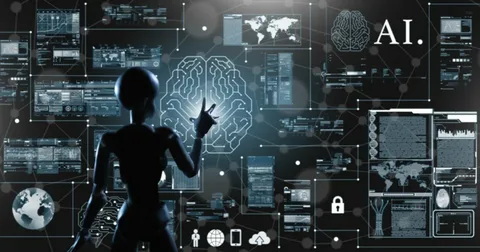As we venture further into 2025, the landscape of teamwork and collaboration has been significantly transformed by artificial intelligence (AI). The surge in AI capabilities has led to the development of various AI collaboration tools that enhance productivity and streamline communication among team members. This article explores the best AI collaboration tools available, how they improve team dynamics, and the role of automation and real-time communication in fostering a collaborative work environment.
What Are AI Collaboration Tools and How Do They Enhance Team Productivity?
Understanding AI Collaboration in the Modern Workplace
AI collaboration tools represent a new paradigm in the workplace, where artificial intelligence integrates seamlessly into daily operations to enhance teamwork and productivity.

These tools facilitate collaborative efforts among team members by providing a platform that supports real-time communication, document collaboration, and task management. The modern workplace increasingly relies on these AI-powered solutions to help teams brainstorm, strategize, and implement their projects more effectively. By using AI, organizations can streamline processes, reduce redundancies, and ensure that all team members are on the same page.
Key Features of Effective AI-Powered Collaboration Tools
Effective AI collaboration tools come packed with features designed to enhance collaboration and productivity. Some of the essential features include task management templates that help teams organize their workflows, built-in communication tools that enable seamless interaction, and AI assistants that summarize discussions and action items. Moreover, AI capabilities allow these tools to learn from user interactions, ultimately improving the user experience over time. By integrating features like automated reminders, status updates, and real-time document collaboration, these tools ensure that team members can focus on their core tasks while the AI manages the logistical aspects of teamwork.
How AI Tools Streamline Communication Among Team Members
One of the most significant advantages of AI collaboration tools is their ability to streamline communication. These tools leverage AI features to analyze communication patterns among team members, identifying potential bottlenecks and suggesting solutions. For instance, platforms like Slack AI and Asana’s AI provide users with insights into their communication habits, enabling them to adjust their interactions for more effective teamwork. Moreover, by utilizing generative AI tools, teams can create documents and presentations collaboratively, ensuring that all input is considered in real-time. This not only enhances collaboration but also fosters a culture of inclusivity and collective problem-solving.
Which Are the Best AI Collaboration Tools for Project Management in 2024?
Top AI Collaboration Tools for Task Management
In 2024, several AI collaboration tools stand out as leading solutions for task management. Tools like Trello, Asana, and Monday.com are at the forefront, offering AI-powered features that simplify project management processes. These platforms allow teams to allocate tasks, set deadlines, and track progress efficiently, all while utilizing automation to minimize manual workload. Integrating these tools with existing workflows ensures that teams can collaborate effectively without the hassle of switching between multiple applications. The ability to automate routine tasks and receive real-time updates significantly boosts team productivity and enables members to focus on high-priority tasks.
How to Choose the Right AI Tool for Your Team
Choosing the right AI collaboration tool for your team involves evaluating several factors, including team size, project complexity, and specific collaboration needs. It’s essential to consider whether the tool offers essential features like document collaboration, task management, and communication capabilities. Additionally, assessing the tool’s integration with existing systems and its scalability for future growth is crucial. Teams should also look for user-friendly interfaces and robust customer support to ensure a smooth transition and effective long-term use. Evaluating trial versions of various AI-powered collaboration platforms can also provide valuable insights into which solution best meets the team’s requirements.
Comparing the Best AI Collaboration Tools for Seamless Integration
When comparing the best AI collaboration tools, it’s vital to consider how seamlessly they integrate with existing workflows. Tools such as Microsoft Teams and Google Workspace offer extensive compatibility with other applications, allowing teams to leverage AI features without disrupting their established processes. The best AI collaboration platforms facilitate smooth data sharing and communication across various systems, ensuring that team members can access all necessary resources without cumbersome transitions. By prioritizing integration capabilities, teams can enhance collaboration and maintain productivity, ultimately leading to successful project outcomes.
How Can AI Collaboration Tools Facilitate Real-Time Communication?
Real-Time Features That Boost Team Collaboration
Real-time communication features are pivotal in enhancing collaboration among team members. AI collaboration tools equipped with chat functionalities, video conferencing, and live document editing enable teams to communicate instantly and effectively. These real-time features allow for immediate feedback and quick decision-making, which are crucial in fast-paced work environments. By utilizing AI to analyze communication dynamics, these tools can suggest optimal times for meetings or highlight when team members are available, ensuring that collaboration happens at the right moment.
Examples of Effective AI Communication Tools
Several AI communication tools stand out for their effectiveness in facilitating teamwork. For instance, Slack AI offers advanced messaging features that utilize AI to filter and summarize conversations, making it easier for team members to keep track of discussions. Similarly, Zoom’s AI capabilities enhance video conferencing by providing background noise cancellation and automatic transcription services. These tools help teams maintain focus during meetings and ensure that all important points are documented for future reference. By incorporating such AI-driven solutions, teams can significantly improve their communication efficiency and overall collaboration.
Benefits of Real-Time Updates in Project Management
Real-time updates in project management foster an environment of transparency and accountability. AI collaboration tools that provide instant notifications about task progress, deadlines, and team activities empower team members to stay informed and engaged. This level of awareness promotes proactive involvement in projects and helps teams quickly identify and address potential issues. Moreover, real-time project tracking enables teams to adapt their strategies on the fly, ensuring that they remain agile and responsive to changes. The benefits of real-time updates extend beyond individual task management; they enhance overall team productivity and morale, leading to successful project outcomes.
What Role Does Automation Play in AI-Powered Collaboration?
How to Automate Routine Tasks for Increased Productivity
Automation plays a critical role in AI-powered collaboration by alleviating team members from repetitive and mundane tasks. By using AI tools to automate routine processes such as scheduling meetings, sending reminders, and tracking progress, teams can significantly increase their productivity. For instance, AI-powered bots can handle administrative tasks, allowing team members to focus on higher-level strategic initiatives. This not only improves efficiency but also enhances job satisfaction as employees can engage in more meaningful work rather than being bogged down by repetitive activities.
Integration of AI Tools to Enhance Workflow Automation
Integrating AI tools into existing workflows is essential for maximizing automation benefits. By ensuring that AI collaboration tools can easily connect with other software applications, teams can create a cohesive ecosystem that enhances productivity. For example, integrating AI tools with CRM systems allows for automatic updates on client interactions without manual input. This level of integration ensures that team members have real-time access to relevant information, enabling them to make informed decisions swiftly. The success of workflow automation hinges on the ability of AI tools to communicate and share data seamlessly across various platforms.
Streamlining Communication Through AI-Driven Automation
AI-driven automation can significantly streamline communication among team members. By automating routine communication tasks, such as sending status updates or follow-up emails, AI tools help maintain the flow of information without overwhelming team members with manual responsibilities. For instance, AI collaboration tools can automatically summarize meeting notes and distribute them to relevant stakeholders, ensuring that everyone remains informed. This not only saves time but also enhances accountability, as team members are more likely to act on the information provided. The combination of streamlined communication and automation leads to a more engaged and productive workforce.
How Do AI Collaboration Tools Support Distributed Teams?
Challenges Faced by Distributed Teams in Collaboration
Distributed teams often face unique challenges in collaboration, such as time zone differences, communication barriers, and varying work styles. These factors can lead to misunderstandings, delays, and a lack of cohesion among team members. AI collaboration tools address these challenges by providing platforms that facilitate effective communication and ensure that all team members have access to the necessary resources, regardless of their location. By leveraging AI capabilities, teams can bridge the gap between different locations and create a more unified and collaborative work environment.
AI Tools That Enhance Collaboration Across Different Locations
Several AI tools are specifically designed to enhance collaboration among distributed teams. Tools like Miro provide virtual whiteboards that allow team members to brainstorm and collaborate in real-time, regardless of their physical locations. Additionally, platforms like Microsoft Teams and Zoom enable seamless video conferencing, fostering face-to-face interactions that strengthen relationships among team members. The integration of AI features within these tools further enhances collaboration, as they can analyze user engagement and suggest optimal ways to improve teamwork across diverse geographical locations.
Best Practices for Using AI Tools in a Distributed Work Environment
To maximize the benefits of AI collaboration tools in a distributed work environment, teams should adopt certain best practices. Establishing clear communication protocols, scheduling regular check-ins, and utilizing shared project management platforms can significantly enhance collaboration. Additionally, providing training on how to effectively use AI tools ensures that all team members are equipped with the necessary skills to engage fully. Encouraging a culture of feedback and adaptability is also crucial, as it allows teams to refine their processes continuously and improve overall productivity. By embracing these practices, distributed teams can thrive in a collaborative environment and achieve their project goals more effectively.




Leave a Comment